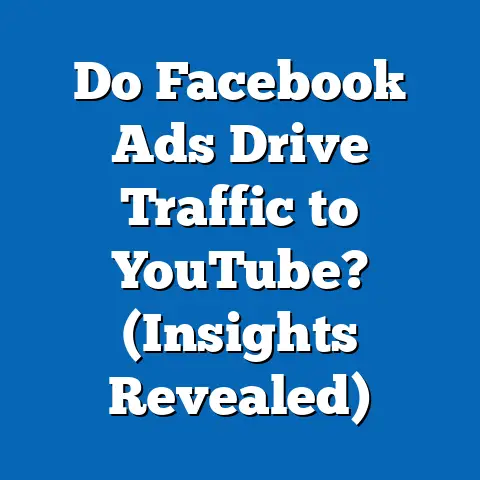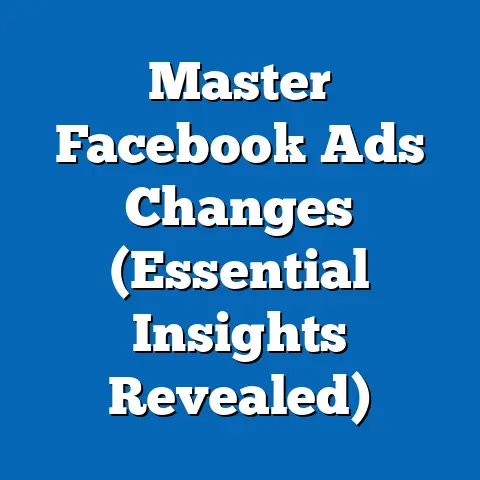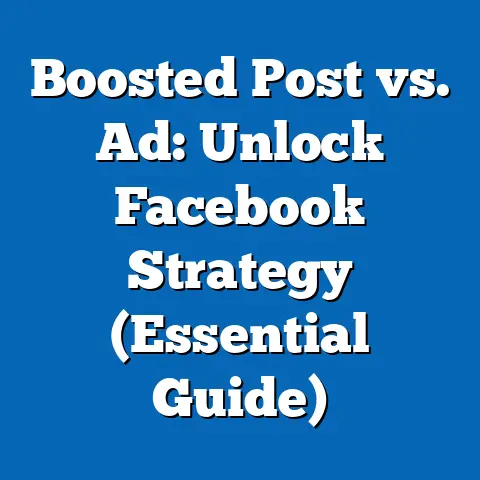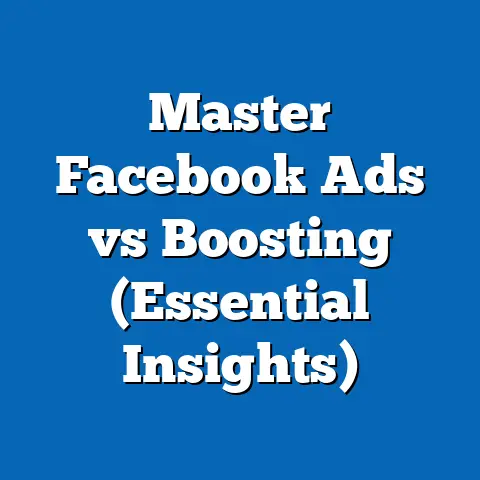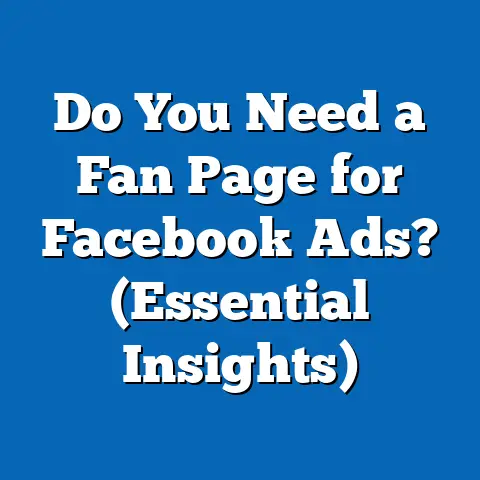Boost Engagement: Unlock More Comments on Facebook Ads (Pro Tips)
I’ve seen it happen countless times. A business pours their heart and soul into crafting the perfect Facebook ad. They’ve got stunning visuals, compelling copy, and a laser-focused target audience. They launch the ad, eagerly anticipating a flood of engagement. But then… crickets. A few likes, maybe a share or two, but the comment section remains a desolate wasteland.
This is a frustrating reality for many marketers, and I understand that struggle firsthand. You’re not just trying to sell something; you’re trying to build a connection, a community. And in the digital age, that connection often starts with a simple comment.
Comments are more than just fleeting interactions; they’re a powerful signal to Facebook’s algorithm, a testament to the relevance and appeal of your ad, and a golden opportunity to engage with potential customers. They can significantly impact your ad’s performance, boosting its visibility and ultimately driving conversions.
In this guide, I’m going to share my hard-earned secrets and pro tips for unlocking more comments on your Facebook ads. We’ll delve into the psychology behind engagement, explore the art of crafting compelling copy and visuals, and uncover actionable strategies for fostering a thriving community around your brand. Let’s transform that desolate comment section into a vibrant hub of conversation!
1. Understanding the Importance of Comments in Facebook Ads
Comments are the lifeblood of engagement on Facebook. Think of them as digital word-of-mouth, amplifying your message and adding credibility to your brand. But their importance goes far beyond just a surface-level interaction.
The Algorithm’s Love Affair with Comments
Facebook’s algorithm, the mysterious force that dictates what users see in their newsfeeds, absolutely loves engagement. And comments are a particularly potent form of engagement. Why? Because they require more effort than a simple like or share. A comment signifies that someone is genuinely interested in what you have to say, and the algorithm rewards this with increased reach.
Essentially, when people comment on your ad, Facebook interprets it as a sign that the ad is relevant and valuable to its audience. This signals the algorithm to show the ad to more people who are likely to be interested, expanding your reach organically. I’ve personally witnessed ads with high comment rates outperform those with just likes and shares, even with the same budget and targeting.
The Power of Social Proof
Humans are social creatures, and we’re heavily influenced by the actions of others. This is the principle of social proof, and it’s a powerful force in marketing. When potential customers see that other people are engaging with your ad, leaving positive comments, and asking questions, they’re more likely to trust your brand and consider your product or service.
Think about it: If you’re browsing through Facebook and stumble upon an ad with hundreds of comments, wouldn’t you be curious to see what everyone is talking about? Those comments act as a form of endorsement, a collective voice saying, “Hey, this might be worth checking out.”
I remember running a campaign for a local restaurant. Initially, the ad received minimal engagement. But after a few customers left glowing reviews in the comment section, the ad’s performance skyrocketed. People were drawn in by the positive feedback, and the restaurant saw a significant increase in reservations.
Real-World Examples of Comment-Driven Success
Let’s look at some examples of how comments can transform an ad’s performance:
- Fashion Brand: A clothing retailer runs an ad showcasing their latest collection. The ad copy asks users to share their favorite outfit from the collection in the comments. The ad receives hundreds of comments, with users tagging friends and discussing their style preferences. This not only boosts engagement but also provides valuable insights into customer preferences.
- Software Company: A tech company launches an ad promoting a new software feature. The ad copy encourages users to ask questions about the feature in the comments. The company actively responds to these questions, providing helpful information and addressing concerns. This builds trust and positions the company as a knowledgeable resource.
- Travel Agency: A travel agency runs an ad featuring a stunning destination. The ad copy asks users to share their dream travel destinations in the comments. The ad receives a flood of responses, with users sharing their bucket list locations and travel stories. This creates a sense of community and inspires others to book their next vacation.
Key Takeaway: Comments are not just a vanity metric; they’re a powerful driver of engagement, social proof, and algorithmic visibility. By understanding their importance, you can prioritize strategies to encourage more comments on your Facebook ads.
2. Identifying Your Target Audience
You can’t expect to spark meaningful conversations if you’re talking to the wrong people. Knowing your target audience is the foundation of any successful Facebook ad campaign, and it’s especially crucial when it comes to generating comments.
Why Audience Research Matters
Imagine trying to tell a joke to someone who doesn’t understand your humor. It’s going to fall flat, right? The same principle applies to your Facebook ads. If your ad copy, visuals, and messaging don’t resonate with your target audience, they’re not going to be motivated to comment.
Audience research allows you to understand your target audience’s demographics (age, gender, location), interests, behaviors, pain points, and motivations. This knowledge enables you to craft ads that speak directly to their needs and desires, making them more likely to engage.
I once worked with a fitness studio that was struggling to attract new clients. Their initial ads were generic and targeted a broad audience. After conducting thorough audience research, we discovered that their ideal clients were busy professionals in their 30s and 40s who were looking for a convenient and effective way to stay in shape. We then tailored our ads to address their specific needs, highlighting the studio’s flexible class schedule and results-oriented workouts. The result? A significant increase in leads and a surge in comments from potential clients.
Methods for Audience Research
Here are some effective methods for conducting audience research:
- Facebook Audience Insights: This free tool provides valuable data about your existing audience and potential customers on Facebook. You can explore demographics, interests, behaviors, and more.
- Customer Surveys: Ask your existing customers about their demographics, interests, pain points, and motivations. You can use online survey tools like SurveyMonkey or Google Forms to collect this data.
- Social Media Listening: Monitor social media conversations related to your industry, your competitors, and your target audience. This can provide valuable insights into their needs and desires.
- Website Analytics: Analyze your website traffic to understand the demographics, interests, and behaviors of your visitors. Tools like Google Analytics can provide this data.
- Competitor Analysis: Analyze your competitors’ social media presence to understand their target audience and their engagement strategies.
Creating Audience Personas
Once you’ve gathered data about your target audience, it’s time to create audience personas. These are fictional representations of your ideal customers, based on your research. A well-defined audience persona includes demographics, interests, behaviors, pain points, motivations, and even a name and a photo.
For example, let’s say you’re selling organic skincare products. Your audience persona might look like this:
- Name: Sarah Miller
- Age: 35
- Occupation: Marketing Manager
- Location: San Francisco, CA
- Interests: Yoga, healthy eating, sustainable living, natural beauty products
- Pain Points: Sensitive skin, concerns about harsh chemicals in skincare products, lack of time for self-care
- Motivations: To find effective and gentle skincare products that align with her values, to prioritize self-care despite her busy schedule.
By creating audience personas, you can humanize your target audience and develop a deeper understanding of their needs and desires. This will help you craft ads that resonate with them on a personal level, making them more likely to engage.
Key Takeaway: Understanding your target audience is paramount to creating engaging Facebook ads. Conduct thorough audience research, create detailed audience personas, and tailor your ads to speak directly to their needs and desires.
3. Crafting Compelling Ad Copy
Now that you know who you’re talking to, it’s time to craft ad copy that grabs their attention and compels them to comment. The words you use can make or break your ad’s performance, so it’s crucial to invest time and effort into crafting compelling and engaging copy.
Elements of Effective Ad Copy
Effective ad copy is clear, concise, and relevant to your target audience. It should also include the following elements:
- A Hook: Start with a captivating hook that grabs the reader’s attention and makes them want to learn more. This could be a question, a surprising statistic, or a bold statement.
- A Value Proposition: Clearly communicate the value of your product or service. What problem does it solve? What benefits does it offer?
- A Call to Action: Tell the reader what you want them to do. Do you want them to visit your website? Download a free guide? Or, in this case, leave a comment?
- Relatable Language: Use language that resonates with your target audience. Avoid jargon and technical terms that they might not understand.
- Emotion: Tap into the emotions of your target audience. What are their hopes, dreams, fears, and frustrations? Use emotion to connect with them on a deeper level.
Examples of Ad Copy That Prompts Comments
Here are some examples of ad copy that successfully prompts users to share their thoughts or experiences:
- “What’s your favorite way to unwind after a long day? Share your tips in the comments below!” This question is open-ended and invites users to share their personal experiences.
- “We’re giving away a free [product] to one lucky commenter! Tell us why you deserve to win.” This contest incentivizes users to leave a comment.
- “What’s the biggest challenge you face when [related to your product]? We’re here to help!” This question identifies a pain point and positions your brand as a helpful resource.
- “Tag a friend who would love this [product]!” This encourages users to tag their friends, expanding your reach and generating more engagement.
- “What’s your favorite [related to your product]? Let us know in the comments!” This question is simple, fun, and easy to answer.
The Power of Storytelling
Storytelling is a powerful tool for engaging your audience and driving comments. Stories can evoke emotions, create connections, and make your brand more relatable.
Instead of simply listing the features of your product, try telling a story about how it has helped someone solve a problem or achieve a goal. This will make your ad more memorable and more likely to generate engagement.
I once worked with a non-profit organization that was raising money for a new community center. Instead of just asking for donations, we created an ad that told the story of a young girl who had benefited from the organization’s programs. The ad featured a video of the girl sharing her experiences and expressing her gratitude. The ad was incredibly effective, generating a surge in donations and a flood of supportive comments.
Key Takeaway: Crafting compelling ad copy is essential for driving comments on your Facebook ads. Use a captivating hook, communicate your value proposition, include a clear call to action, use relatable language, and tap into the emotions of your target audience. And don’t underestimate the power of storytelling.
4. Visual Elements That Drive Comments
While compelling ad copy is crucial, don’t underestimate the power of visuals. A captivating image or video can grab attention, evoke emotions, and ultimately drive more comments on your Facebook ads.
Complementing Ad Copy with Visuals
Visual content should complement your ad copy and reinforce your message. It should also be relevant to your target audience and visually appealing.
Think of your visual as the first impression. It’s what initially catches the eye and encourages users to stop scrolling. If your visual is dull, irrelevant, or low-quality, people are likely to skip right past your ad.
The Importance of High-Quality Images and Videos
In the age of high-resolution displays and social media platforms that prioritize visual content, high-quality images and videos are non-negotiable. Blurry, pixelated, or poorly lit visuals will make your brand look unprofessional and untrustworthy.
Invest in professional photography or videography if possible. If you’re on a budget, there are plenty of free or low-cost stock photo and video websites that offer high-quality content. Just make sure the images or videos you choose are relevant to your brand and target audience.
Creative Visual Strategies
Here are some creative visual strategies that can encourage users to comment:
- Polls: Use Facebook’s poll feature to ask users a question related to your product or service. This is a simple and effective way to generate engagement.
- Quizzes: Create a fun and engaging quiz that relates to your brand or industry. Encourage users to share their results in the comments.
- Interactive Content: Use interactive content like 360-degree photos or videos to create a more immersive experience.
- Behind-the-Scenes Content: Give users a glimpse behind the scenes of your business. This can make your brand more relatable and human.
- User-Generated Content: Feature user-generated content in your ads. This can build trust and encourage other users to share their experiences.
I ran a campaign for a local bakery that featured a series of mouth-watering photos of their pastries. Each photo included a question in the caption, such as “What’s your favorite pastry?” or “What’s the first pastry you’d grab from this display?” The ads generated a ton of comments, with users sharing their favorite pastries and tagging friends who they thought would enjoy them.
Key Takeaway: Visual content is a powerful tool for driving comments on your Facebook ads. Use high-quality images and videos that complement your ad copy and are relevant to your target audience. And don’t be afraid to get creative with polls, quizzes, interactive content, and user-generated content.
5. Utilizing Call-to-Action Strategies
A clear and compelling call to action (CTA) is essential for driving any desired action, including comments. Your CTA tells users exactly what you want them to do, removing any ambiguity and increasing the likelihood that they’ll take action.
Types of Calls to Action
There are many different types of CTAs you can use to drive comments on your Facebook ads. Here are some examples:
- Ask a Question: “What’s your favorite [related to your product]?” “What’s the biggest challenge you face when [related to your product]?”
- Invite Users to Share: “Share your tips in the comments below!” “Share your story with us!”
- Encourage Tagging: “Tag a friend who would love this!” “Tag someone who needs this in their life!”
- Run a Contest: “Comment to enter to win a free [product]!” “Tell us why you deserve to win!”
- Solicit Opinions: “What do you think of our new [product]?” “Which [option] do you prefer?”
Concrete Examples of Effective CTAs
Here are some concrete examples of effective CTAs that prompt users to share their opinions or experiences:
- “We’re launching a new flavor of our [product]. What flavor should we launch next? Let us know in the comments!” This CTA invites users to participate in the decision-making process, making them feel valued and engaged.
- “We’re celebrating our anniversary! Share your favorite memory of our [business] in the comments below.” This CTA taps into nostalgia and encourages users to share positive experiences.
- “We’re looking for feedback on our new website design. What do you think? Let us know in the comments!” This CTA shows that you value user feedback and are committed to improving their experience.
- “We’re giving away a free [product] to one lucky commenter who shares their biggest challenge when [related to your product]. Comment below to enter!” This CTA combines a contest with a request for valuable feedback.
- “We’re launching a new campaign to support [cause]. Share your story of how [cause] has impacted your life in the comments below.” This CTA aligns your brand with a social cause and encourages users to share their personal experiences.
Placement and Timing of CTAs
The placement and timing of your CTA can also impact its effectiveness.
- Placement: Your CTA should be prominently displayed in your ad copy, ideally near the end. This ensures that users have all the information they need before being asked to take action.
- Timing: The timing of your CTA should be appropriate for the stage of the customer journey. If you’re targeting new customers, you might want to focus on building awareness and generating interest before asking them to comment. If you’re targeting existing customers, you can be more direct in your CTA.
I worked with a local bookstore that was launching a new book club. Their initial ad simply announced the book club and asked users to sign up. The ad received minimal engagement. After revising the ad copy to include a more compelling CTA (“What’s your favorite book of all time? Share it in the comments!”), the ad’s performance improved dramatically. People were eager to share their favorite books and connect with other book lovers.
Key Takeaway: A clear and compelling CTA is essential for driving comments on your Facebook ads. Use a variety of CTAs to encourage different types of engagement. Pay attention to the placement and timing of your CTAs to maximize their effectiveness.
6. Encouraging User-Generated Content
User-generated content (UGC) is any content (text, images, videos, etc.) created by your customers or fans. It’s a powerful form of social proof that can significantly boost engagement and drive comments on your Facebook ads.
Benefits of User-Generated Content
UGC offers a multitude of benefits:
- Increased Trust: UGC is perceived as more authentic and trustworthy than branded content.
- Higher Engagement: UGC is more likely to resonate with potential customers, leading to higher engagement rates.
- Cost-Effective: UGC is often free or low-cost to acquire.
- Brand Advocacy: UGC turns your customers into brand advocates, spreading positive word-of-mouth.
Strategies for Encouraging UGC
Here are some strategies for encouraging customers to share their experiences or photos related to your brand:
- Run Contests: Host contests that encourage users to submit photos or videos featuring your products or services.
- Create Hashtags: Create a branded hashtag and encourage users to use it when sharing content related to your brand.
- Feature UGC in Your Ads: Showcase user-generated content in your Facebook ads. This can build trust and encourage other users to share their experiences.
- Offer Incentives: Offer incentives, such as discounts or free products, to users who share content related to your brand.
- Ask for Reviews: Encourage customers to leave reviews on your Facebook page or website. Positive reviews can be featured in your ads.
Creating Campaigns That Invite User Participation
Here’s how to create campaigns that invite users to participate and share:
- Photo Challenges: Launch a photo challenge that encourages users to submit photos related to a specific theme.
- Video Contests: Host a video contest that encourages users to create short videos featuring your products or services.
- Storytelling Campaigns: Invite users to share their stories about how your brand has impacted their lives.
- Product Review Campaigns: Encourage users to write reviews about your products or services and share them on social media.
- “Before & After” Campaigns: Invite users to share “before & after” photos or videos showcasing the results they’ve achieved with your products or services.
I worked with a cosmetics company that launched a “Makeup Transformation” campaign. They encouraged users to share “before & after” photos of their makeup looks using the company’s products. The campaign was a huge success, generating a ton of UGC and driving a significant increase in sales. The company then featured the best submissions in their Facebook ads, further boosting engagement and social proof.
Key Takeaway: User-generated content is a powerful tool for boosting engagement and driving comments on your Facebook ads. Encourage customers to share their experiences and photos related to your brand, and feature UGC in your ads to build trust and social proof.
7. Engaging with Comments After They’re Made
Generating comments is only half the battle. The real magic happens when you actively engage with those comments, fostering a community and encouraging further interaction.
The Importance of Active Engagement
Imagine leaving a comment on an ad, only to be met with silence. You’d probably feel ignored and less likely to engage with that brand in the future.
Actively engaging with comments shows that you value your customers’ opinions and are committed to providing excellent customer service. It also creates a sense of community and encourages other users to join the conversation.
Tips for Responding to Comments Effectively
Here are some tips for responding to comments effectively:
- Respond Promptly: Respond to comments as quickly as possible, ideally within a few hours.
- Be Polite and Professional: Always be polite and professional, even when responding to negative comments.
- Personalize Your Responses: Avoid generic responses. Personalize your responses to show that you’ve actually read the comment and are addressing the user’s specific concerns.
- Ask Follow-Up Questions: Ask follow-up questions to encourage further conversation.
- Offer Solutions: If someone is complaining about a problem, offer a solution or direct them to the appropriate resources.
- Show Appreciation: Thank users for their comments and let them know that you appreciate their feedback.
Handling Negative Comments Constructively
Negative comments are inevitable, but they don’t have to be a disaster. In fact, they can be an opportunity to demonstrate your commitment to customer service and turn a negative experience into a positive one.
Here’s how to handle negative comments constructively:
- Acknowledge the Issue: Acknowledge the user’s concerns and apologize for any inconvenience they may have experienced.
- Offer a Solution: Offer a solution to the problem, such as a refund, a replacement, or a discount.
- Take the Conversation Offline: If the issue is complex or sensitive, offer to take the conversation offline by providing a phone number or email address.
- Don’t Argue: Avoid getting into arguments with users. This will only escalate the situation and make your brand look bad.
- Learn from the Feedback: Use negative feedback to identify areas where you can improve your products or services.
I once worked with a restaurant that received a negative comment on their Facebook ad about slow service. The restaurant owner responded promptly, apologizing for the slow service and offering the user a free appetizer on their next visit. The user was impressed by the owner’s response and changed their review to a positive one.
Key Takeaway: Actively engaging with comments is crucial for fostering a community and encouraging further interaction. Respond to comments promptly, be polite and professional, personalize your responses, and handle negative comments constructively.
8. Analyzing and Adapting Strategies
The world of Facebook advertising is constantly evolving, so it’s essential to continuously analyze your results and adapt your strategies accordingly. What works today might not work tomorrow, so you need to be proactive in monitoring your performance and making adjustments as needed.
Tracking and Analyzing Comments
Here’s how to track and analyze comments on your Facebook ads:
- Facebook Ads Manager: Use Facebook Ads Manager to track the number of comments your ads are receiving. You can also see the sentiment of the comments (positive, negative, or neutral).
- Social Media Monitoring Tools: Use social media monitoring tools like Hootsuite or Sprout Social to track comments related to your brand and your ads.
- Manual Analysis: Manually review the comments on your ads to get a better understanding of what users are saying.
Tools and Metrics for Assessing Engagement
Here are some tools and metrics that can help you assess engagement levels:
- Comment Rate: The number of comments divided by the number of impressions. This metric tells you how engaging your ads are.
- Sentiment Analysis: The overall sentiment of the comments (positive, negative, or neutral). This metric tells you how users feel about your brand and your ads.
- Engagement Rate: The total number of likes, comments, and shares divided by the number of impressions. This metric gives you a comprehensive view of engagement.
- Reach: The number of unique users who saw your ad. This metric tells you how many people your ad is reaching.
- Frequency: The average number of times each user saw your ad. This metric tells you how often users are seeing your ad.
Continuous Improvement and Experimentation
Based on your analysis, you can adjust your strategies to improve your results. This might involve:
- Refining Your Target Audience: If your ads aren’t resonating with your target audience, you might need to refine your targeting.
- Revising Your Ad Copy: If your ad copy isn’t compelling, you might need to revise it to make it more engaging.
- Changing Your Visuals: If your visuals aren’t capturing attention, you might need to change them to something more visually appealing.
- Adjusting Your CTAs: If your CTAs aren’t driving comments, you might need to adjust them to make them more clear and compelling.
- Experimenting with Different Ad Formats: Try experimenting with different ad formats, such as video ads, carousel ads, or collection ads.
I worked with an e-commerce company that was struggling to generate comments on their Facebook ads. After analyzing their results, we discovered that their ads were reaching a broad audience, but they weren’t resonating with the right people. We then refined their targeting to focus on users who were specifically interested in their products. We also revised their ad copy to make it more engaging and relevant to their target audience. As a result, their comment rate increased significantly.
Key Takeaway: Continuously analyze your results and adapt your strategies accordingly. Use Facebook Ads Manager and social media monitoring tools to track your performance. Experiment with different ad formats, targeting options, and ad copy to find what works best for your brand.
Conclusion
Boosting comments on Facebook ads is not a one-time fix; it’s an ongoing process that requires a blend of creativity, audience understanding, and active engagement. By understanding the importance of comments, identifying your target audience, crafting compelling ad copy, using effective visuals, utilizing strategic CTAs, encouraging user-generated content, engaging with comments, and analyzing your results, you can transform your Facebook ads from a silent broadcast into a vibrant conversation.
Remember, the goal is not just to get more comments; it’s to build a community around your brand and create meaningful connections with your customers. By focusing on providing value, fostering engagement, and building relationships, you can unlock the full potential of Facebook advertising and achieve your business goals.
So, go ahead and implement these pro tips, experiment with different strategies, and observe the transformation in your ad engagement levels over time. I’m confident that you’ll see a significant improvement in your results. Now, go out there and start the conversation!

